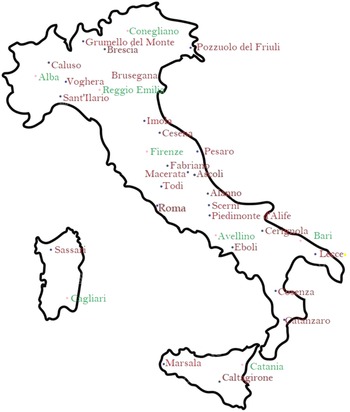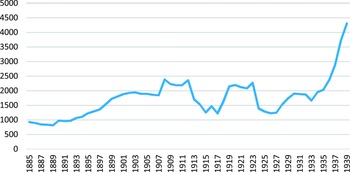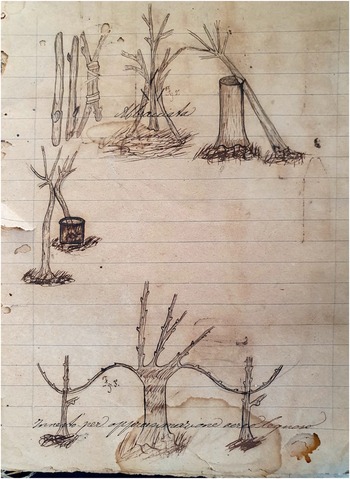Introduction
The link between human capital and industrialisation is well established having been the subject of numerous analyses.Footnote 1 This link, however, remains little tested in relation to agriculture. Some basic aspects of the relationship await systematic study, for example, assessing the impact.Footnote 2 Libraries, conferences, books, newspaper, and schooling have all, to varying degrees, been subject to academic scrutiny.Footnote 3 But irrefutable evidence is lacking, and therefore it is necessary to resort to a plurality of approaches. What is certain is that in European countries the globalisation of trade and the ‘agrarian crisis’ of the late nineteenth century accelerated the political debate on the urgent need to improve the productive inputs predominant in the continental countryside, a requirement that involved using the lever of education to encourage the increase in the stock of knowledge and production capacities. As research shows, in the nineteenth century, lines of thought were consolidated in Europe that defended the economic and social centrality of agriculture. In many cases, these were conservative movements opposed to the novelties generated by the advance of industrialisation, but it is clear that the ‘ruralist’ ideology.Footnote 4 Within this epistemological framework lies the ethics of increasing productivity and economic modernisation to be instilled in owners and farmers also through school training.Footnote 5
Agricultural organisation at the turn of the century became increasingly complex and competitive and required the use of workers and administrators capable of understanding and applying the technological changes taking place.Footnote 6 At the end of the nineteenth century, at the same time that land ownership continued to be a factor of prestige and status,Footnote 7 the economic progress deriving from industrialisation and the expansion of international trade created the conditions for agriculture to become a vector of social growth. Teachers, dealers of machines and chemical fertilisers, sales representatives, agronomists all became increasingly influential figures in rural society.Footnote 8 Indeed, the technical and scientific skills required by agricultural renewal encouraged the birth of a heterogeneous class of professionals trained through public educational provision.
What remains/is elitist
Along with university studies,Footnote 9 European countries (Germany, Prussia, and Austria) are committed to the diversification of training through the creation of educational paths aimed at strengthening the technical disciplines of an applicative nature.Footnote 10 The result of this vision of modernisation was the establishment of an educational hierarchy that expands from universities and research centres to include a multiplicity of schools, courses, circles, and academies. It was the ‘useful knowledge’ that Mokyr places at the basis of the leap forward of the modern economy.Footnote 11 In this way and as this article referring to Italy demonstrates, a field of analysis is identified that investigates both the creation of a favourable context for the circulation of knowledge in agriculture and the consolidation of a training process necessary for the modernisation of agriculture. However, there are differences between countries. While formal agricultural education advanced slowly in England, state interventions proliferated on the European continent as early as the first half of the nineteenth century.Footnote 12 In Germany from the first half of the nineteenth century, the Ackerbauschule (schools of agriculture) were founded and in France in 1848 the fermes-écoles and the écoles agricoles régionales were born, institutions later replaced by the école pratiques. The same dynamics also pertained in other Western countries, notably Austria, Belgium, Spain, and the United States,Footnote 13 where governments encouraged extensive educational action through the foundation of agricultural study and also through research centres.Footnote 14
Whilst Paul Brassley has considered this issue from the point of view of the skills possessed by English landowners,Footnote 15 the focus of this paper shifts attention to the creation of a public educational programme in the Kingdom of Italy through which agricultural progress was to be advanced. Notwithstanding that resistance to agricultural change were many,Footnote 16 by the mid-nineteenth century, Pietro Cuppari (1816–1870), father of the modern Italian agricultural economy, was able to relate that farms had to become modern factories with technical and administrative offices equipped with trained personnel.Footnote 17 If the attention here is the significant shifts in attitude and outlook in the second half of the nineteenth century and the early years of the twentieth century, the same problems any dynamics persisted across Europe even after the Second World War when the recovery plans of national agriculture required not so much the intervention of personnel with solid theoretical knowledge but the participation of intermediaries and educators with a high level of technical education.Footnote 18
In the context of a rich panorama of initiatives, this contribution examines the post-elementary school system born in Italy after the 1870s. In order to respond to the challenges imposed by foreign competition and social dynamics, between the 1870s and 1880s, the first steps were taken in the formation of a specific public teaching system intended specifically for the qualification of technicians and figures management in agriculture in Italy.Footnote 19 The main purpose of the educational institutions was to improve the production system by renewing the intermediate educational level.
Founded after 1877 throughout the peninsula and financed by the state and local administrations, the history of the royal practical and special schools of agriculture offers the opportunity to examine one of the main characteristics of the Italian educational offer in the agricultural teaching sector.Footnote 20 Compared to other European countries where scientific research or the schooling of farmers and small owners to transform them into ‘good citizens’ was stronger,Footnote 21 our case study demonstrates that in Italy the policy of encouraging the training of technical figures took priority. The initial phase of this policy decision can be located in last decades of the nineteenth century and in the period before the beginning of the First World War. The evolution of education continued thereafter, but with the arrival of fascism in 1922 the nature of agricultural schools undergoes a radical change. Leaving aside the phase of fascism when educational institutions were filled with strong ideological values, the period under consideration is characterised by rapid growth and consolidation. At the height of the ‘agrarian crisis’ in Italy, a public educational offer was created for the birth of a modern workforce integrated by farm managers (‘fattori’), technicians, and educated agronomists. Since the main feature of Italian agriculture at the end of the nineteenth century was the importance of large landowners,Footnote 22 the economic modernisation of farms depended mainly on the recruitment of personnel with high managerial skills. From the point of view of the organisation of resources, we understand the difference that existed between agricultural training in France where the main objective was to improve the productive quality of small owners, and Italy where the resistance of large owners to socioeconomic changes impelled technical modernisation.
Based on the idea that the growth of agricultural know-how depended on the joint action of owners and scientifically qualified management personnel,Footnote 23 this study questions the role of the state in the creation of knowledge in agriculture. Adopting the theories of Harold Perkin,Footnote 24 the students who left the practical and special schools of agriculture after a formal course, on which they were awarded with a diploma, contributed decisively to the professionalisation of Italian agriculture. They were an educated, diverse, and skilled workforce that claimed an income that matched their status. The documentation this paper draws upon combines edited but also unpublished, comes from public and private archives: statistical collections, official reports, and private correspondence. In this, the biographies of the students who graduated from schools warrant a further note. Created in the 1920s in order to demonstrate the accumulated professional experience, the biographies are first-hand material of significant historical value. In addition to providing abundant information on personal and professional paths, at the same time they demonstrate that agricultural schools in Italy play an irreplaceable role in the formation of an elite of agricultural technicians who identified with the economic progress of the nation. The curricula of the students, to take up what was said previously on the tools with which to measure the impact of agricultural modernisation, are a direct documentation of the results achieved by public schooling to create an adequate human capital for the transformations that took place in agriculture between the 1870s and the First World War.
The birth of an agrarian school system in Italy
In 1861, after the birth of the Kingdom of Italy, agrarian teaching in Italy was rudimentary and inadequate. The best-known experience was the Tuscan school of Meleto founded by the marquis Cosimo Ridolfi in 1832Footnote 25 . It lasted only a decade and did not have the strength to change an educational context that was not inclined to face the issues of training and transmission of skills among farmers. A national reference framework had not been definedFootnote 26 and the initiatives reminded of the enlightenment spirit of the eighteenth century.Footnote 27 The agricultural colonies that depended on religious and charity institutions aimed to equip orphans and abandoned children with some rudimentary agricultural knowledge based on basic notions of plants and animals, seasons, and the stars which governed the rhythms of nature.Footnote 28 The most used didactic material were almanacs and the ‘catechism for farmers’ which emphasised the order God had imposed on society.Footnote 29
Following the example of other European countries, in 1862 Minister Filippo Cordova presented a project that included three levels: high schools to train given the urgency to provide Italy with a school system which could be compared to the system that was already in force in other European countries, in 1862 the ministry Filippo Cordova presented the project ‘Regulation of special agricultural education’. The regulation established three levels of education: high schools where professors of agriculture were trained; farms-schools where smart and practical ‘farm foremen’ were trained; and agrarian colonies where workers in the agricultural field were trained. In addition, special schools of cultivation were also set up to improve agrarian farms, which were considered to be strategically important. In the first attempts to introduce a school system dedicated to agriculture in Italy, the objective was clear of giving more importance to the practical aspects of teaching, reserving less importance to theory. However and despite trying to find a balance to avoid that the law was considered too innovative as it aimed to improve the educational condition of the rural population, the creation of a training system aimed at teaching science and technique to farmers raised resistance and criticisms, which led to the failure of the law proposals, the creation of a training system aimed at teaching science and technique to farmers raised resistance and criticisms, which led to the failure of the law proposals.
The lack of reforms to the educational offer was justified with the argument that, after the end of their studies, the young would leave the fields and go to work in the cities, where it was easier for those who had received some training to find a well-paid occupation in trade and industry. The failure of the reform was in effect a function of the ruling power bloc in parliament, as well as the large land owners, who considered agriculture a private rather than state matter. Those less inclined to change argued that, for farmers’ children, some experience and a basic school training giving elementary notions were sufficient.Footnote 30 Eventually, a compromise was reached through the creation of an agronomy section in technical institutes.
After the first post-unification years when no significant political changes occurred, in the 1870s the national political framework underwent a profound shift with the arrival in power of the ‘historical left’, which was also an expression of the interests of the bourgeoisie and of land ownership more open to international markets.Footnote 31 In the 1870s and 1880s, a series of events took place which required a change in Italian agricultural policy. The customs crisis in France reduced exports of agricultural products and the arrival of large quantities of grain and other commodities from abroad, and Italian agriculture needed urgent reforms. It seemed necessary to create a school system capable of facing the challenges required by the industrial transformation of the world economy. Although the dispute between the conservative and reformist camp remained, the demands imposed by economic development created the conditions for the consolidation of a favourable context for the creation of a public agricultural educational system oriented to the training of qualified personnel to be employed both in farms and in agricultural industries and also in public bodies.Footnote 32
To create an educational system in the agricultural sector, Italy had as a model in continental Europe, especially so in Germany and Prussia, but it adapted the experiences of these countries until the formation of a system that adapted to the specific socio-economic conditions of the country. Germany was the most obvious example of the emergence of technical education institutes at the university level. Following the path of industrial polytechnics, higher technical education in Germany was entrusted to a series of high schools on which the progress of national agriculture depended. Growing up from the early decades of the nineteenth century, in the middle of the century, the royal academies were connected to universities and already in the sixties there were agricultural faculties in Leipzig, Berlin, Göttingen, Wroclawe, and many other German cities. At the end of the nineteenth century in Germany, there were fourteen university and autonomous agricultural schools attended by more than 2,500 students, with a total annual financial endowment of around 2 million francs. For Italian observers, the professional training of engineers and qualified technical personnel was the real strength of the modernisation of German agriculture.Footnote 33 At the average teaching level, the intervention of the state also included the existence of agricultural high schools that prepared for entry into higher and university institutions. To all this were then added numerous two-year practical schools for peasants and small owners. In neighbouring Prussia, the high number of agricultural secondary schools and special agricultural schools were of interest, more than 150 including 35 girls’ schools of domestic and rural economics and a varied number of practical schools of forestry, beekeeping, brewing, etc.Footnote 34
Italy aspired to follow the German model, but the starting point was determined as by the restricted availability of funding and also the lack of interest of the children of large farmers in agricultural studies. In fact, for the upper classes in Italy, studies had to be carried out in qualifying sectors such as law or engineering, while agriculture had little following. In Italy between 1871 and 1872, the agricultural university institutes of Milan, Portici, and Pisa were born. In 1896, a fourth agricultural institute arrived in Perugia, but at the university level the provision and enrolment remained low. As shown in Table 1, the students who attended university courses in agriculture were relatively few compared to Germany, and therefore the renewal of Italian agriculture could hardly come from the university classrooms. In the agronomic reality that was emerging in Italy in the last decades of the nineteenth century, the question of agricultural teaching involved posing the problem of the transfer of knowledge in such a way that it could reach wider sectors of rural society. The significant shift occurred in 1878, when the Minister of Agriculture proposed a system of some practical agricultural education at secondary level. To respond to the rapid technical and organisational transformation that was affecting the primary sector, the objective of the law was the foundation of practical schools of agriculture in each province at the same time that a series of special national schools came into operation. If the purpose of the practical schools of agriculture was to train managers of farms expert in the best agricultural practices, instead the special schools were entrusted with the task of promoting the modernisation of agriculture through the training of technical personnel in some key productive sectors for the national economy (oenology, olive growing, livestock farming, dairy farming, forestry, and fruit growing).
Table 1. Special schools and agricultural practices in Italy (year 1900)
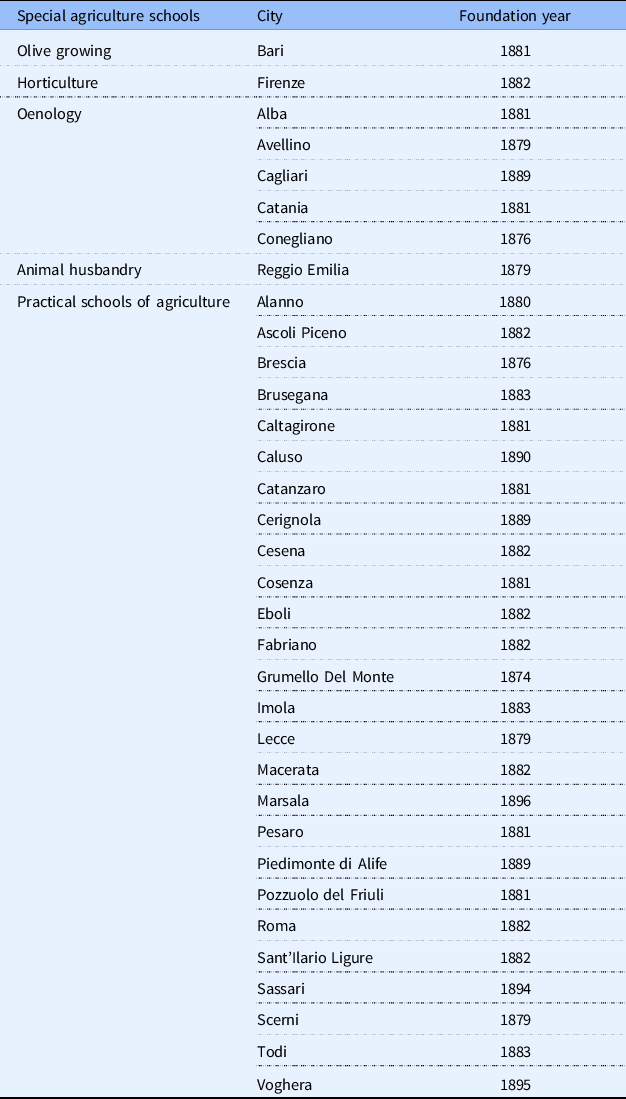
Source: created by the author with data from created by the author with data from da Vittorio Stringher, L’istruzione e la sperimentazione agraria (Roma, 1911), p. 33.
Despite ongoing disagreements as to role of the state in the provision of agricultural education, law no. 3141 of 6 June 1885 created practical and special agricultural schools in Italy.Footnote 35 Italian law, broadly following the French example,Footnote 36 required students aged 14–15 years to have passed basic elementary education but left each school fully autonomous in defining programmes and organising teaching. Students, except those who had obtained a scholarship or financial aid from some public or private body, had to pay an annual fee that ranged between 150 and 400 lire, plus have available clothes, shoes, and other material necessary for the school life. Thus to attend agricultural schools, it was necessary to have some economic resources. Although the students of the public practical and special schools were exclusively boys,Footnote 37 the girls were not completely excluded from the wave of agricultural training. In Italy, a series of private educational institutions came into operation aimed at providing orphaned girls with some basic knowledge in agricultural activities considered typically feminine such as the breeding of silkworms, the management of courtyard animals, beekeeping, floriculture, and other occupations designed for women. One of these educational centres was the Female Agricultural Practice School, founded in 1902 in Milan by the Jewish woman Aurelia Josz (1869–1944) who had up to thirty female students.Footnote 38
Studies in practical schools lasted three years, and sometimes a quarter year could be added to deepen subjects such as accounting. Theoretical teachings were Italian language, arithmetic, history, geography, geometric design, economics and rural legislation, botany, zoology, agricultural topography, and rural constructions. In the schools of viticulture and oenology, the theoretical-practical study was carried out in two cycles (lower and upper). The lower course of two or three years was intended for chief winemakers and cellarmen, while the upper course of four years aimed at preparing directors of wineries and oenological farms. The special subjects taught in the higher course were viticulture, oenology, and economic enotechnics; chemical technology; plant pathology; geometric drawing; notions of applied mechanics, surveying and construction; and compilation of technical and economic projects (Figure 1).
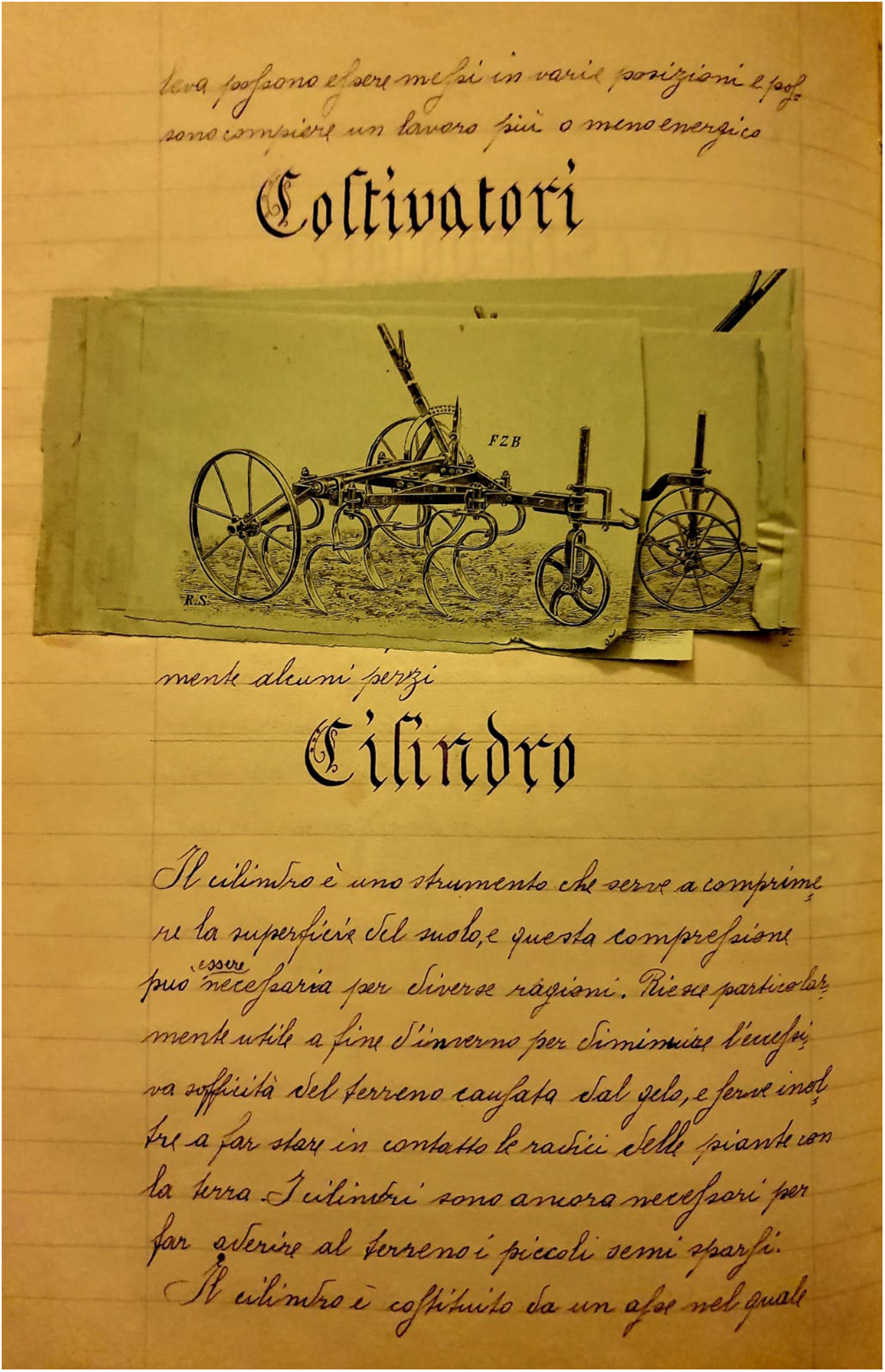
Figure 1. Page of a notebook with notes on mechanical problems (early twentieth century).
Source: Private property.
In the practical schools, the theoretical lessons covered about eighteen hours a week, while five to eight hours a day were dedicated to manual work. Although the teaching had a decidedly practical profile, initially the organisation of school cycles and the relationship between theoretical and practical education fuelled discussions demonstrating that professionalisation in agriculture could favour profound changes. One of the main obstacles was to precisely define the concept of practical education to be kept distinct from a generic ‘teaching to work’. From this point of view, the French situation shows that in European countries, professional teaching in agriculture has encountered difficulties. In fact, of the seventy-eight fermes-écoles born in 1848, only thirty-four remained active in 1875,Footnote 39 the year in which the école pratiques d’agriculture came into operation. Whilst in France at the end of the nineteenth century, there were sixty-six schools and universities active in agricultural teaching,Footnote 40 in Italy there were only thirty-nine: five higher agricultural institutes (Pisa, Portici, Milan, Bologna, and Perugia); eight special schools: oenology and viticulture (Alba, Conegliano, Avellino, Catania, and Cagliari), forestry (Florence), animal husbandry and dairy (Reggio Emilia), olive growing (Bari), and twenty-six practical schools (see Table 1) (Figure 2).Footnote 41
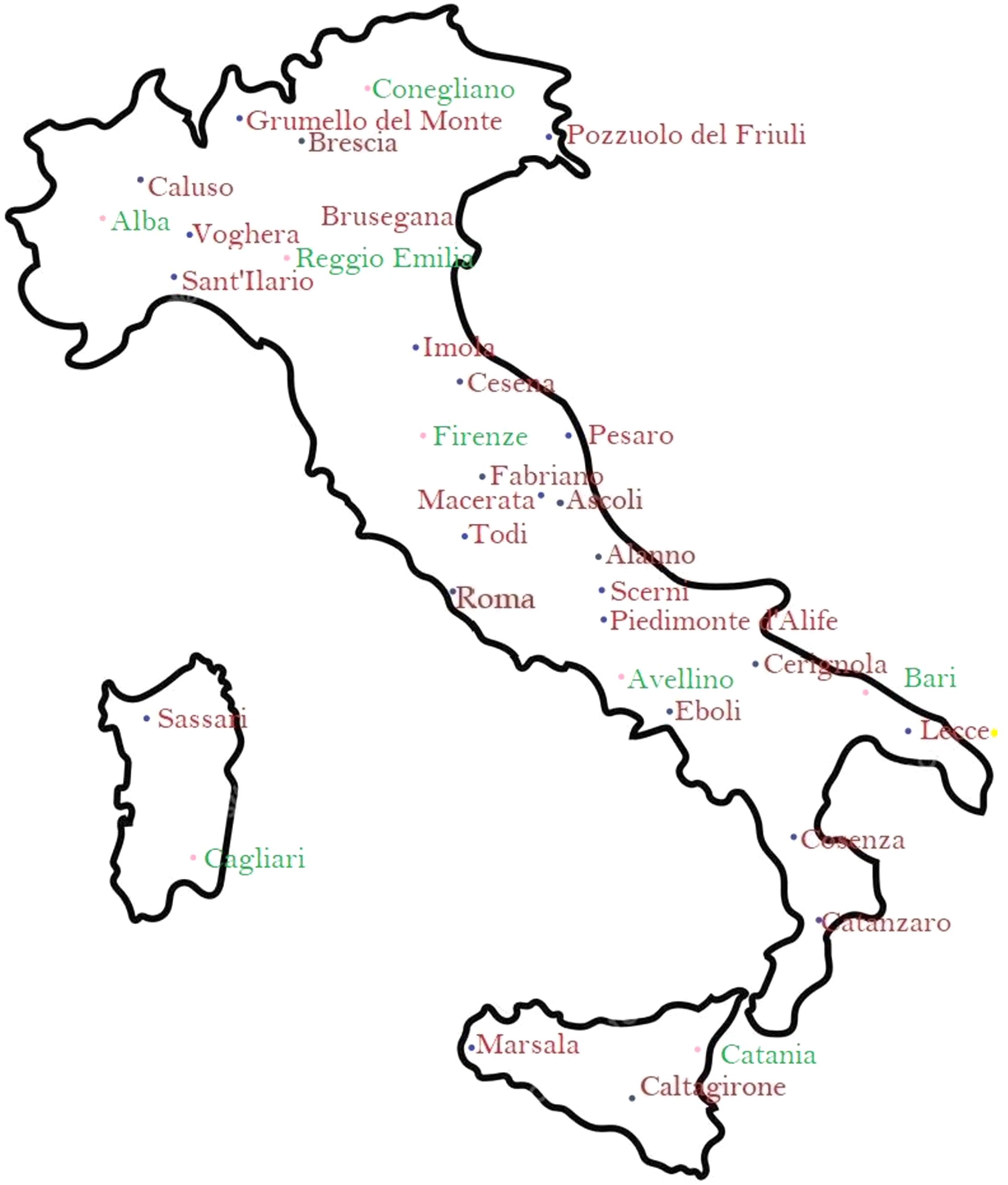
Figure 2. Practical and special schools of agriculture in Italy (year 1900).
Source: created by the author with data from created by the author with data from da Vittorio Stringher, L’istruzione e la sperimentazione agraria (Roma, 1911), pp. 34-35.
Geographically, the practical and special schools of agriculture covered the entire country despite the fact that a vacuum is observed for Tuscany (see Figure 3). The lack of governmental educational institutions in this region is partly explained by the existence of some important private schools with more than two thousand students written in the last two decades of the nineteenth century.Footnote 42 In general, there are no major regional differences and the attempt to use the network of schools as a tool for modernisation of the southern areas of the country where the backwardness of production structures in agriculture was stronger was felt. The most serious situation occurred in Sicily where, at the end of the nineteenth century, the presence of the feudal estate was still very strong, imposing a very poor agriculture, but also in other southern Italian regions, an agriculture that favoured cereal growing and livestock transhumant.Footnote 43 Also with regard to special schools, there is a choice that combines the agricultural vocation of the individual territories (animal husbandry in Reggio Emilia or olive growing in Bari) at the same time that an attempt is made to favour the agro-industrial development of the south through the development of the wine sector, a strategy that sees the foundation of the schools of Catania, Avellino, and Cagliari.
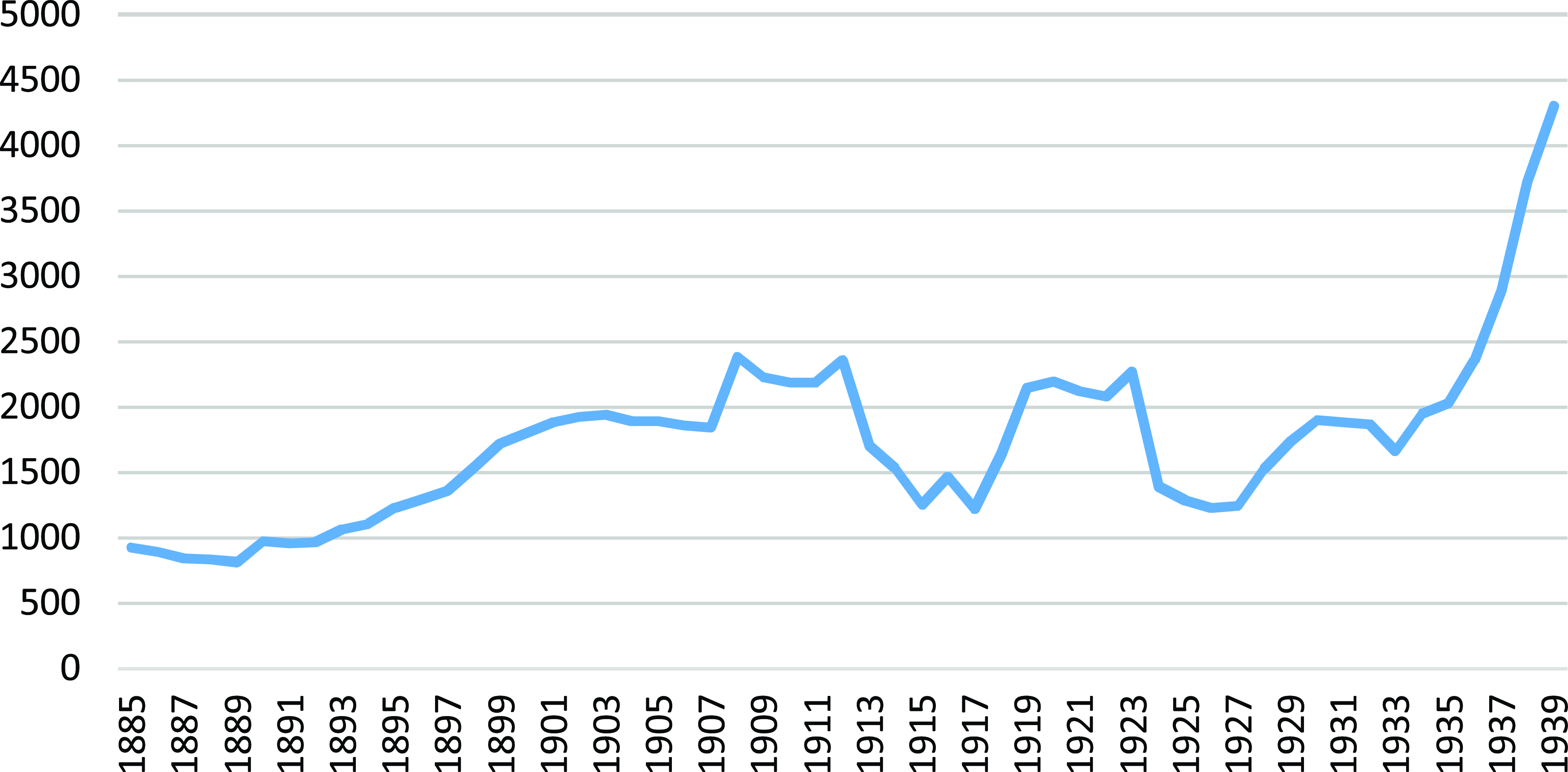
Figure 3. Students enrolled in practical and special agriculture schools. Italy (years 1885–1939).
Source: see Table 2.
The schools are a clear attempt to reduce the large differences in economic development that plagued Italian agriculture at the end of the nineteenth century. Public funding exceeded one million lire in 1886–87, a figure that rose to a total of 2.5 million lire in the first ten years of the twentieth centuryFootnote 44 Funds from municipalities, provinces, and individuals must be added to the funding from the central government, plus the income from the sale of farm products belonging to schools. In addition to teaching, agricultural schools are dedicated to the publication of numerous magazines and educational material which today constitutes a rich book material of great importance for investigating the circulation of agricultural research.
The number of students present in the different agricultural schools active in Italy constitutes a useful criteria for measuring the progressive accumulation of human capital in agriculture. In 1885, the pupils of the practical and special schools of agriculture were 926, by the end of the century the number had grown to 1,721 students. In the early twentieth century, the number of students continues to increase to 2,382 in 1907. The trend stabilises until 1912 (see Table 2). Starting from 1913, there was a decline that reached its lowest point between 1915 and 1917 due to the entry of Italy into the First World War. Once the conflict was over, enrolments started to rise again and in 1920 the limit of 2,000 students was once again exceeded (see Table 2). Leaving aside the disruption of the war years, in comparative terms from an enrolment perspective, Italy and France from the end of the nineteenth century were broadly similar with about 2,400 students.
Table 2. Students enrolled in Italy in practical, special, and high schools of agriculture (years 1885–1920)
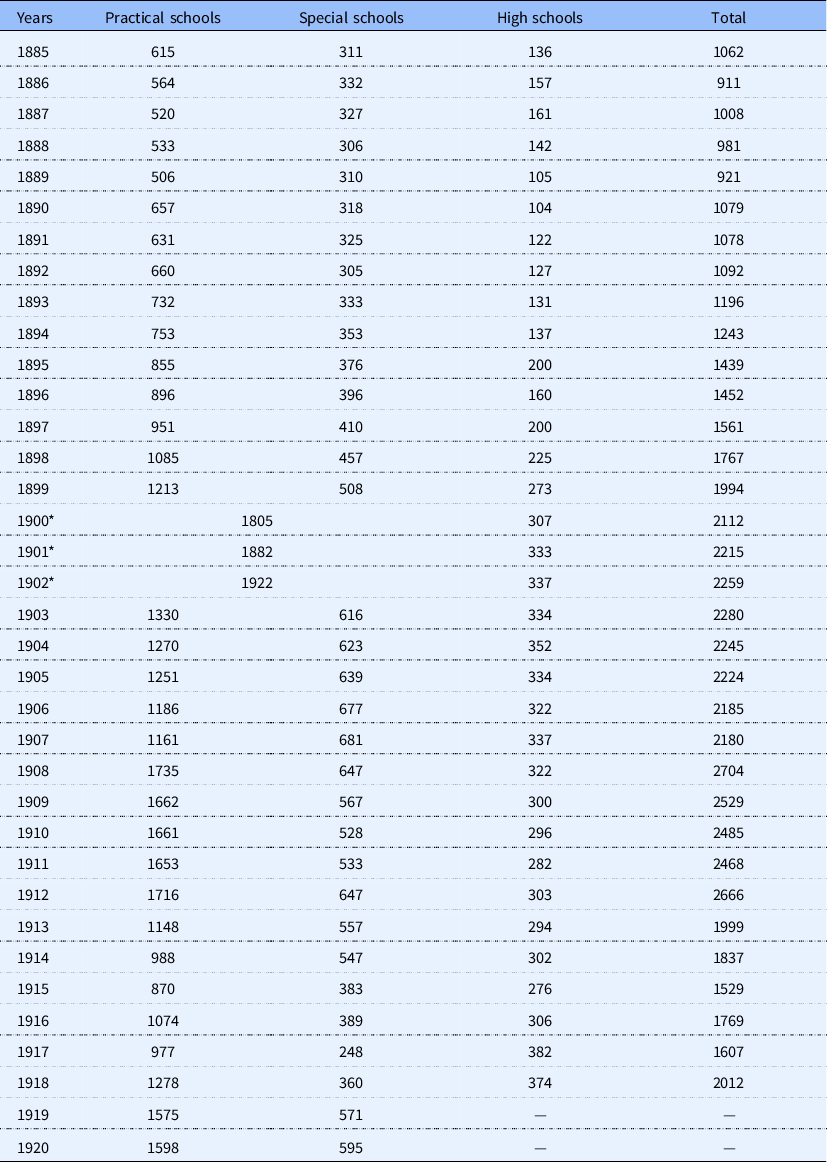
Source: Annuario statistico italiano, ad annum.
*In these years (1900–1902), the statistics unite the students of the practical schools and special schools.
In percentage terms, and including high school students, it is observed that the greatest weight of agricultural teaching in Italy corresponded to practical schools with 64% followed by special schools with 24%. The university level is present with 12%. Between 1885 and 1920, the students who attended agricultural courses in intermediate schools were 56,088. Of these, about 11,217, 20%, completed their studies and eventually received a degree or diploma. Through this mechanism of schooling, in fact, with the release of an official title, a common point was created between university graduates and students who had obtained a diploma after finishing their studies at the middle schools of agriculture. In this way, the possession of an ‘official title’ from a social point of view represented an important goal and from an economic point of view they created new opportunities for qualified work in a global agricultural context dominated by the need for technical and trained personnel. It is no coincidence that many graduates from Italian agricultural schools emigrated to the American continent (not least to Argentina, United States, and Brazil) where the demand for professionals with specific technical and managerial profiles was high.Footnote 45
In terms of the socio-economic condition of the families of the students enrolled in agricultural schools, 6.1% belonged to a heterogeneous group of ‘farmers’, 17.1% to directors of farms, and another 17% to large- and medium-sized owners. The largest proportion – 40% – corresponded to the children of small owners, with a substantial 23% from the artisans and trade sector. When in 1893 the ministry of agriculture made an initial assessment of the results achieved after ten years of activity,Footnote 46 the opinions coming from the governing bodies of the schools attest that initial expectations had been confounded. The school managers related that the aim of the training offer in the technical-practical education sector was not the training of ‘good farmers’ but the much more ambitious aim of raising the level of farm managers, directors, and agricultural professions. However, one of the major critical points highlighted by the governing bodies of the schools was the socio-economic origin of the pupils because in principle the educational offer was not designed for the children of traders and small artisans. Thus, in reality, the starting point was the erroneous idea of a society clearly divided into two broad categories: owners and farmers. Instead, once they entered into operation, the agricultural schools created dynamics of social and economic growth through formal training.Footnote 47
Unwittingly, the public school system stimulated the creation of a rural society with greater professional diversification. A composite galaxy of figures able to grasp the openings generated by the growing industrialisation of agriculture was inserted between the owners of the farms and the farmers. The students present in practical and special schools show that in Italy the technical renewal linked to agriculture is essentially located at the intermediate levels of the school training system. From this comparison, it can be appreciated that the main objective of the state educational provision in agriculture was the creation of a base of experts and administrators who could be entrusted to modernise farms-based production.
The results of the massive deployment of public means and resources to modernise the country’s agriculture can be seen by observing the professional activities carried out by young people who have come out of practical and special schools of agriculture. According to official information, young people in possession of a licence issued by a practical or special school of agriculture could find work in ministries, in reclamation consortia, in wineries and agriculture, in itinerant professorships dedicating themselves to teaching, in embassies abroad as wine technicians, in the editorial offices of newspapers amongst other professions.Footnote 48 This fact is important because when we analyse the relationship between agricultural innovation and education, we sometimes tend to give too much weight to informal mechanisms without taking into consideration that many of the communicators engaged in the creation of articles, books, courses, and lessons were trained, in agriculture schools.Footnote 49 Herein, the curriculum of school students is of critical importance. Of the 1,473 young people who graduated from practical and special schools between 1904 and 1909 (see Table 3), 332 (22.5%) found work on farms, occupying the position of administrators, specialised personnel, and accountants, 513 (35%) returned home to devote themselves to managing the family properties, 332 (22.5%) continued their studies especially in the schools of oenology or colonial agriculture, 77 (5%) began an independent profession connected in some way to agriculture, and 219 (15%) appear in the statistics without a specific occupation.
Table 3. Occupation of students graduated from practical schools of agriculture in Italy (years 1904–1909)

Source: Stringher, 1911, p. 83.
Official statistics, however, do not allow us to grasp the economic profiles that actually existed. Rural society in Italy at the end of the nineteenth century appears to be characterised by the presence of numerous socio-professional figures who are difficult to position. As the biographies written by the graduating students reveal, returning home to take care of the family businesses did not mean giving up what was learned. The young people applied the acquired knowledge as evidenced by the start of industrial activities with tobacco, sugar beet, rational breeding, or the construction of new buildings (silos, stables, and cellars). There are also cases of young graduates who, together with directing the family business, also managed the farms of other owners or dedicated themselves to teaching. In this way, mixed professional activities emerge that easily escape a vision of rural society divided solely between owners and peasants.Footnote 50
In the first census (1861) carried out after political unity, veterinarians and horse workers (mariscalchi) appear among the liberal professionals, but no mention is made of farm managers or similar figures.Footnote 51 On the other hand, in the censuses of the 1970s and 1980s, there were 23,840 administrators, concentrated especially in Lombardy, Veneto, and Tuscany.Footnote 52 By 1901, the group of administrators is 29,133 (+21%). If we compare these data with the entire agricultural population over the age of ten years, we see that the group of agricultural administrators is very minor.
Table 4 highlights the weight of the large group of day labourers and the day workers in the agricultural population in Italy. They represented an immense reservoir of unskilled reserve labour available to the country’s large farms. If we then see the other larger group, the heterogeneous category of sharecroppers, settlers, and tenants, we come to over 70%. At the same time, we see the smaller numerical consistency that agricultural owners had in Italy, only 19%. In any case, the data that is interesting to highlight is that the professionalisation of agriculture mainly involves the small group of agricultural agents: 41.021, a very low 0.5%. In 1881, the group of farm administrators consisted of 23,840 people, 962 of whom were women and with a greater presence in Lombardy, Veneto, and Tuscany.Footnote 53 So between these two dates (1881–1911), we can see the increase of this professional category thanks to the role played by the agricultural schools. Despite the low number, it constitutes the most dynamic professional category from which the technicians and managers employed in the farms came out. Unfortunately, the Italian population censuses do not include information on the studies carried out or on the possession of a school qualification or diploma. Our available data are incomplete, but the presence in the censuses that took place in 1900 of the category of oenologists employed in oenological establishments, a professional figure who came out of the special schools of viticulture and oenology, confirms that the school system created at the end of the nineteenth century had contributed to raise the level of the workforce available to modernise agriculture.
Table 4. Agricultural population over ten years of age in Italy (year 1911)

Source: L’Italia agricola e il suo avvenire, Roma, tip. della R. Accademia dei Lincei, 1919, p. xcix.
The ‘farm foremen’: managing agricultural farms
Traditionally, the administration of large farms in Italy was the task of the factor, a figure with a commando role that was placed between the owners and the settlers. In the absence of the owner who lived in the city and who visited his lands a few times a year, the farmer had a key function of intermediary between ownership and work. The factor has been present in Italian agriculture since the Middle Ages, and the purpose of many of the agronomy treaties written in Italy during the modern age is to describe the characteristics that a good administrator must have.Footnote 54 Usually, the factors were the children of peasants who were recruited as helpers by ability and then, once the owner’s trust was gained, move on to occupy the main position of director even in the absence of formal education.
In the 1870s, before the foundation of the practical schools of agriculture, the aforementioned Pietro Cuppari claimed that limited study was sufficient to become a good farm manager because agricultural knowledge came from practice, observation, and natural disposition.Footnote 55 As numerous cases show, the rule was to rely on sending written letters and messages to convey information and advice; through constant correspondence the administrators had to keep accounts in order, to supervise the peasants and to scrupulously carry out the instructions received as a ‘good and diligent father of a family’.Footnote 56 The administrators were obliged to scrupulously respect the indications of the owners to put into practice the ‘rules of agricultural art’ handed down from generation to generation. Starting from the second half of the nineteenth century, there was no shortage of innovations regarding the transmission of news and information by the owners. In this sense, there are numerous testimonies of letters and messages written by the owners and directed to the directors of the companies including information on the cultivation of vines (see Figure 4), on storage of sugar beets, on the use of pesticide chemicals, on the conservation of organic fertilisers, and on the correct storage of foodstuffs.Footnote 57 These informal messages, to be searched in the private archives of farms, are a concrete example of the circulation of information and the creation of common knowledge networks in agriculture. In this context, the directors had a reduced capacity for autonomy. Only in the case of the sale of livestock did less rigid management logics predominate.
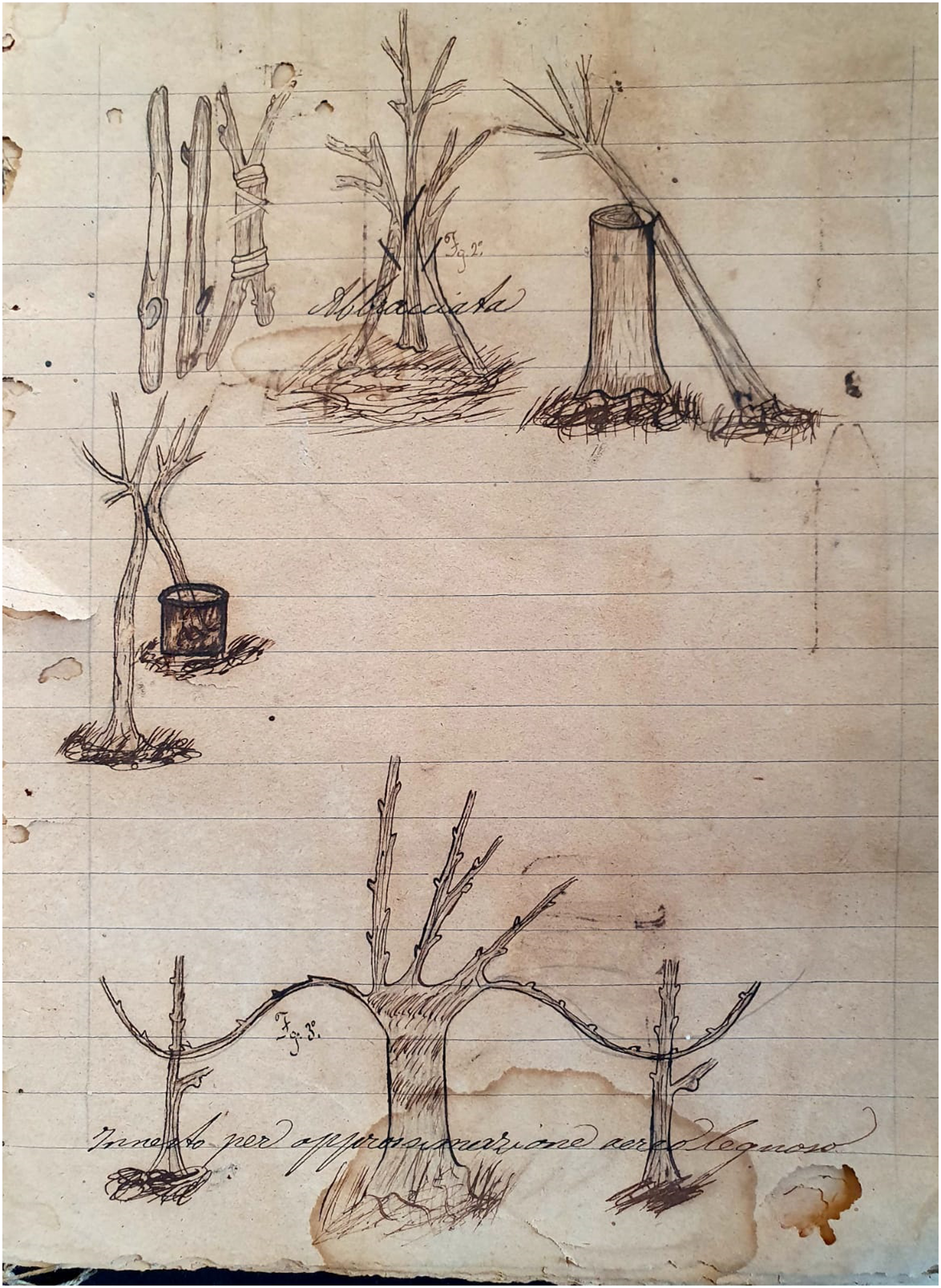
Figure 4. Page of a notebook with instructions for pruning and growing vines (early twentieth century).
Source: Private property.
Despite the weight of tradition, in the second half of the nineteenth century the administrators, in the absence of chemical knowledge on fermentation processes, recognised that they did not know why the wine acquired off flavours and became vinegar.Footnote 58 Equally it became important to have knowledge in mechanics, hydraulics, technical drawing, and other useful subjects to be used for a better and more efficient management of farms.Footnote 59 During the second half of the nineteenth century, a large series of innovations, not always positive, pushed towards the creation of a training system which consisted of solving problems of enormous importance for a country like Italy which had an essentially agricultural economy. It became important to know the functioning of the new machines (tractors and threshing machines) but also the essential chemical products to fight the diseases that damaged the vines or silkworms. The same can be said for the construction of stables for animals or the creation of water channelling systems. These are just a few examples of an agriculture that needed technical knowledge and professional training. It even became essential to learn how to use the microscope, incubators, and telegraphs without neglecting practical knowledge in the creation of packaging and packaging suitable for shipping products abroad. In the letters written by the traditional factors to the owners at the end of the nineteenth century, the meaning of the transformations taking place is grasped, the effort to acquire knowledge by turning to experts for advice and news on agricultural matters. It is admitted that it was no longer possible to give up school: ‘It is so necessary to study’.Footnote 60 Compared to the past, agriculture in the late nineteenth century encouraged the formation of a professional conscience among agricultural technicians and farm managers. The economic differences between the Italian regions do not disappear, but a national context is created in which faith in technical-scientific progress becomes a common trait of the graduates and the teaching staff to be put at the service of the construction of the country’s agriculture.Footnote 61 Therefore, the professionalisation of farm administrators testifies to the discontinuity that generated the technical-economic modernisation in Italian agriculture.
If for the Italian economy the qualified training of the personnel who governed the farms was a fundamental requirement for the growth of agriculture, for the farmers and the owners, however, following the indications of a technical and trained company manager could become a reason for conflict. In the schools, a professional elite was created that faced resistance farmers and owners who did not always accept the changes introduced by the educated administrators who were eager to put into practice ‘the improvements recommended by modern technology’. If among the peasants a hostile attitude towards the introduction of works that required more time and more effort was widespread, larger landowners showed a low propensity for novelties that involved too high costs. Another source of friction between landowners and the new technicians were professionals’ wages. For many, salaries were not adequate for the professional and personal status of staff with an academic qualification. Even beyond the temporal confines of this study, the youngest of those who did not participate in the First World War when applying for positions of administrative responsibility readily indicated that they had a qualification issued by a practical or special school of agriculture.Footnote 62
Although the scope of this paper ends before the arrival of fascism in power, it should be remembered that in the mid-twenties the government decided to recognise young people who had studied in agriculture schools a specific professional title, perito agrario. To participate in the tests required by law, it was necessary to submit a report indicating the positions held and any useful information to demonstrate the professional qualities achieved. The main result of this operation is the existence of dozens of autobiographical files documenting the experiences of students who graduated from agricultural schools between the late nineteenth and early twentieth centuries.Footnote 63 The documentation composes a large repertoire of autobiographical information, and it is confirmed that agricultural schools played an irreplaceable role in Italy in the technical and organisational modernisation of farms.
In search of skilled, well-paid jobs, the biographies of young graduates who have graduated from agricultural schools document a high propensity for geographical mobility and employment. The displacement of agricultural school graduates is a topic of great importance not only regarding personal paths but also because the mobility of qualified personnel contributed to the formation of national agriculture. The schools contributed to the formation of an educated human capital in agriculture that moved freely by changing workplace and transferring knowledge between farms. The same trend applies to the professors and directors of agricultural schools. They too frequently changed teaching locations. In this way, the circulation of both teaching staff and professionals favoured the formation of a national agricultural economy that faced problems in an integrated manner.Footnote 64 Certainly, the movement of teachers between schools favoured the creation of a common network of knowledge and agricultural knowledge.
A characteristic of the students who graduated from agricultural schools was their total faith in economic progress through technical and organisational rationalisation. There are numerous testimonies on the introduction of new cultivation systems, on the use of tractors and threshers, on chemical treatments to combat plant diseases, on the selection of breeds, and on the construction of stables and storage buildings. There is also constant evidence on industrial plants, on agricultural industries (wine, oil, sugar, and tobacco), on the drainage of fields, on the rationalisation of crops, and thus on a wide range of elements of modernisation. The news created tensions. The conflicts with the owners, with the peasants, and with the old administrators were assiduous. In this way, the clash between the forces of modernisation and conservation is captured in agriculture.Footnote 65
Another aspect to underline is the belief on the part of the authors of the biographies of the need to achieve maximum organisational efficiency by transferring the logic of the industrial system to farms. It was essential to set the production factors according to the increase in yields and profit margins. According to this approach, farms had to respond to requests from the market. The written report presented by the administrator of the Il Borro farm in Tuscany owned by Prince Emanuele Filiberto, Duke of Aosta herein is instructive.Footnote 66 The report relates that the vines, olive trees, and mulberries were renewed for a total of over 15,000 new plants; the chemical fertilisation of the land was improved; the cultivation of artificial lawns was intensified; the types of wheat were selected (Gentil rosso, Gentil bianco, and Varrone); poplars, chestnuts, firs, and other fruit trees were planted for a total of almost 41,500 plants; the cultivation of sugar beets and ‘Kentucky’ tobacco varieties began to be experimented; and the breeds of cattle, pigs, and sheep improved. From 1916 and 1923, as shown by the awards obtained in agricultural exhibitions, thanks to this series of improvements the production of silkworms went from 16 to 43 quintalsFootnote 67 ; wheat exceeded 1,200 quintals while wine increased from 673 to 1,249 quintals and oil from 28 to 176 quintals. New houses were built for the peasants and new stables, cellars, and service buildings. The average wheat yield increased from 9.98 to 14.36 quintals per hectare. According to the report of the administrator of this company that we can use as an example of a general trend, the improvements obtained could continue to grow to involve all branches and sectors of agriculture.
Conclusions
In Italy, as a consequence of the industrial revolution in agriculture, from the beginning of the eighties of the nineteenth century, educated personnel who could facilitate the agrarian progress of the country established themselves. This is the result of an educational policy financed by the government and public local administrations. The Italian experience, particularly significant in the passage towards the twentieth century, became a model for other countries that were creating a professional training system which could respond adequately to the challenges imposed by agriculture during the first globalisation. A case in point is represented by Argentina. Starting from the 1880s, the Latin-American country began providing education in the sector of technical agriculture, especially as far as the development of one of the main agricultural resources of the country was concerned, that is, wine growing. Since the Argentinian government intended to use the more advanced knowledge of European countries in this specific sector, it granted financial support to the young who wanted to enrol at agrarian schools in France and Italy.Footnote 68 In this way, in a key sector like that of wine and following the example of the Italian school of Conegliano, Argentina managed to take advantage of what the young trained in Europe had learned. Hence, also by investing in the qualification of human resources, Argentina could locate itself among the main world powers in terms of wine production and trading.Footnote 69 It is a clear example of the circulation and transfer of knowledge in agriculture.
In consideration of what has been seen, the Italian trajectory is placed in the context of the historiographical debate on the role of the State in the change of economic paradigm through investments in education and training.Footnote 70 The empirical findings show that government action proved essential at the end of the nineteenth century. In Italy, at first, it was evident that the institutionalisation of a public educational offer in the agricultural sector offered the possibility of introducing numerous elements of novelty and change. Thanks to the formation of a large network of schools and institutions geographically distributed throughout the country, the rural population had the opportunity to progress. It improved the socio-economic status of many families. Without reaching the level of university education, the practical and special schools of agriculture, a characteristic aspect of the Italian educational offer in agriculture, gave many young people from the ranks of the varied class of farmers the opportunity to reach a degree and acquire a professional specialisation. Faced with pressures from rural society, many of the rigid schemes and hierarchies still existing until then began to fall. Having a son who graduated from an agricultural school became a source of pride and socio-economic progress for many peasant and smallholder families.
At the beginning of the twentieth century, the most obvious result of the processes that had taken place in the previous decades was the entry of young graduates of practical and special schools into the labour market, but the school system did not guarantee agricultural school students a definite vocational placement. The rather contradictory result was the existence of human capital in agriculture that did not possess a defined socio-economic role. These novelties created conflict and hostility especially after the end of the First World War when farms had to open up to the contribution of technology and mechanisation to compensate for the lack of labour. In addition, the war years had demonstrated the advances in chemistry to be used even in agriculture to combat plant diseases Italian agriculture was changing and modernisation was not welcomed by all, including graduates coming out of university who considered school technicians an inferior category.
Despite resistance, a variety of opportunities opened up for young people graduating from agricultural schools. Some went into technical professions related to agriculture such as surveyors, machine builders, and measurers. Others found employment in the central and provincial public administration and occupied positions as professors, managers of land reclamation and agrarian consortia, oenologists at wine and oil factories, etc. For others, the largest number, the way was to enter the labour market as farm managers. This is the main consequence of the formation of human capital in agriculture thanks to the role of technical education.
But it will be fascism that will mark a turning point in the history of agricultural technicians in Italy. For Mussolini, modernisation in agriculture had to be first and foremost technical to be achieved through rational farms led by qualified technical personnel. In this way, a professional figure (the agricultural expert) was created who, after completing his studies in middle school, could carry out a profession fully recognised by the state. In this way, fascism utilised the previous school system by entrusting technicians with a social role. This is one of the main features of Italian agricultural modernisation. In this way, thanks to the state educational system, in the transition from the nineteenth to the twentieth century, a technocratic vision was consolidated that would remain after 1945 when post-war reconstruction continued to guarantee agricultural technicians (periti agricoli) an important role in Italian agriculture.
Acknowledgements
This research was supported by the Research Fund of the University of Perugia, 2021.





